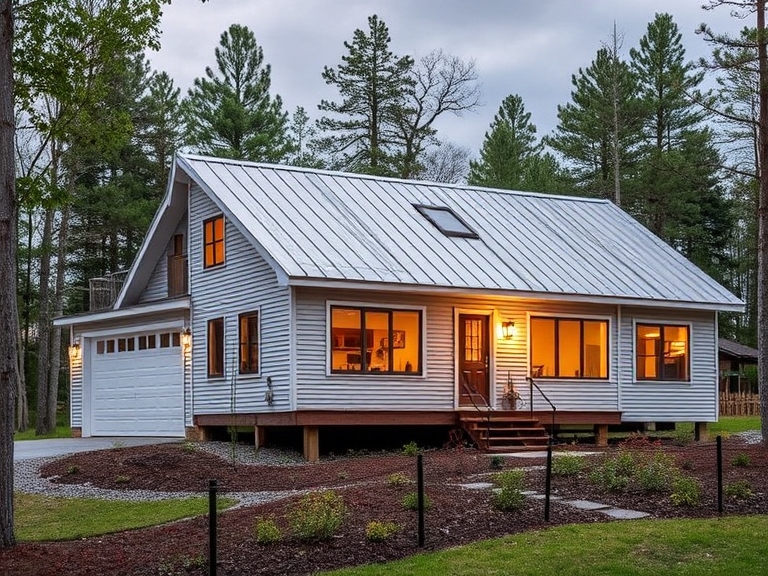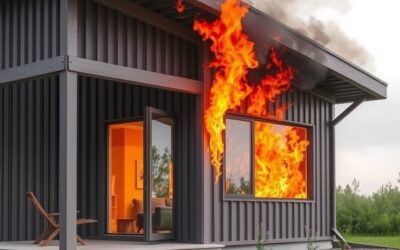Fire safety is a top priority when building a home. The materials used in construction play a significant role in protecting residents from the dangers of fire. Steel homes provide a level of fire resistance that far surpasses traditional building materials like wood. Understanding how steel helps keep you safe can guide you in making informed choices for your home.
Steel is inherently non-combustible. This means it does not burn or contribute fuel to a fire, unlike wood, which can easily ignite and spread flames. The fire-resistant properties of steel make it a strong contender for those looking to build a safe and secure home. Even under extreme temperatures, steel retains its structural integrity, ensuring your home remains intact and stable during a fire.
Choosing an all-steel construction means that every part of your home’s framework is designed to withstand fire. This comprehensive approach to fire safety provides peace of mind and enhances the overall protection of your home.
Understanding the Fire-Resistant Properties of Steel
Steel is famous for its exceptional fire-resistant properties. Unlike wood, steel does not catch fire and burn. This makes it a great choice for home construction. Because steel is non-combustible, it does not contribute any fuel to a fire. This significantly reduces the risk of fire spreading throughout the home.
One of the key features of steel is its ability to retain structural integrity under high temperatures. When a fire breaks out, materials like wood can weaken and collapse. Steel, on the other hand, remains strong even at temperatures exceeding 1,000 degrees Fahrenheit. This makes it much safer for occupants, giving them more time to evacuate if a fire occurs.
Additionally, steel does not release toxic fumes when exposed to fire. Many traditional building materials can emit harmful gases that pose serious health risks. Steel’s lack of emissions ensures that the indoor air remains safer during a fire, reducing the risk of smoke inhalation and other respiratory issues.
Overall, the fire-resistant properties of steel make it an excellent choice for anyone looking to build a safer home. Its non-combustibility, structural integrity, and lack of toxic emissions provide substantial protection against fire hazards.
Benefits of All-Steel Construction in Fire Safety
Choosing all-steel construction offers several fire safety advantages. First, an all-steel framework ensures that every part of your home’s structure is fire-resistant. From the roof to the walls and floor, steel provides a comprehensive layer of protection. This uniformity can be crucial in preventing the spread of fire and maintaining structural stability.
Another benefit is reduced insurance costs. Homes made from fire-resistant materials like steel often qualify for lower insurance premiums. Insurance companies recognize the reduced risk of fire damage, translating to savings on homeowner’s insurance. This financial incentive can be a substantial benefit for those looking to protect their investment.
Steel homes also contribute to better emergency response. In the event of a fire, firefighters can more effectively combat flames in a steel structure. The reduced risk of collapse and slower spread of fire give emergency responders more time to extinguish the blaze and rescue occupants. This can make a significant difference in the outcome of a fire emergency.
Finally, building with steel aligns with sustainability goals. Steel is recyclable and can be repurposed without losing its strength. This means that using steel not only increases fire safety but also supports environmental responsibility.
An all-steel construction offers robust fire protection, potential cost savings, and environmental benefits, making it a wise choice for modern homebuilding.
Comparative Analysis: Steel vs. Traditional Building Materials
Steel outperforms traditional materials like wood and concrete in fire safety. Wood is highly flammable and can easily ignite, contributing to a faster spread of fire. Steel, by contrast, does not burn, making it a much safer option for construction. This non-combustibility is one of steel’s most significant advantages over wood.
Concrete is another common building material, known for its fire resistance. While concrete does provide decent fire protection, it lacks the flexibility and strength of steel. Over time, exposure to high temperatures can cause concrete to crack and weaken. Steel, however, maintains its structural integrity even when exposed to extreme heat. This makes steel a more reliable choice in terms of long-term fire safety.
Steel also has the advantage of being lightweight compared to concrete, which can simplify construction and reduce the overall load on a building’s foundation. Additionally, steel’s ability to be prefabricated means quicker and more efficient building processes, further enhancing its appeal over traditional materials.
Overall, while wood and concrete each have their merits, steel’s superior fire-resistant properties make it the preferred choice for building a safe and durable home.
Best Practices for Enhancing Fire Safety in Steel Homes
While steel offers inherent fire resistance, there are extra steps to boost your home’s safety. One important practice is to install a comprehensive fire alarm system. An effective fire alarm can give you crucial early warning, providing more time to evacuate and call emergency services.
Another best practice is to use fire-resistant materials for interior finishes and furnishings. While the structure of your home might be fire-resistant, using flammable materials indoors can still pose risks. Opt for fire-resistant paint, drywall, and carpeting to further safeguard your home.
Regular maintenance and inspections also play a vital role in fire safety. Ensure that electrical systems are up-to-date and free from potential hazards. Faulty wiring can lead to electrical fires, which could compromise any building material. Periodically check smoke detectors, fire extinguishers, and sprinkler systems to ensure they are in working condition.
Creating and practicing a fire evacuation plan is another essential step. Establish clear escape routes and ensure all family members know what to do in case of a fire. Regular drills help ensure everyone can evacuate quickly and safely if the need arises.
By implementing these best practices, you can maximize the fire safety of your steel home and ensure the well-being of your family.
Conclusion
Building a steel home brings unbeatable fire safety advantages. Steel’s fire-resistant properties make it an excellent choice for constructing a safe and durable home. Unlike traditional materials such as wood and concrete, steel does not ignite or weaken under high temperatures. This provides invaluable protection against the dangers of fire.
Opting for all-steel construction ensures that every part of your home benefits from these fire-resistant qualities. This comprehensive approach significantly reduces the risk of fire spread and structural collapse. Additional best practices, such as installing fire alarms, using fire-resistant interior materials, and performing regular maintenance, further enhance the fire safety of steel homes.
If you’re considering building a home that prioritizes safety, style, and functionality, a steel home with steel building insulated panels could be the perfect choice for you. Contact Wink Panels LLC today to learn how these panels can enhance fire resistance and overall safety. Our experts are here to help you design and build the safest home possible.




